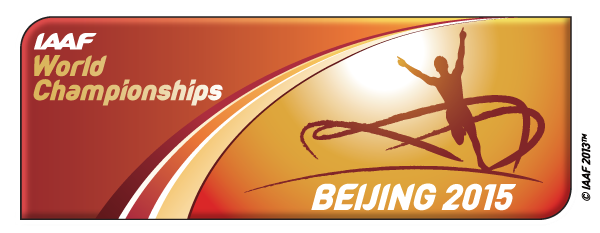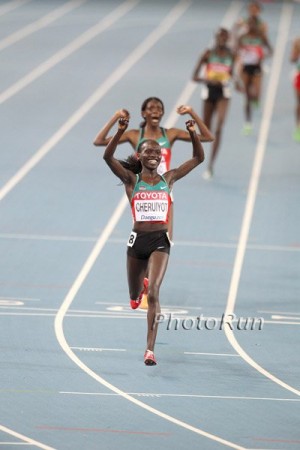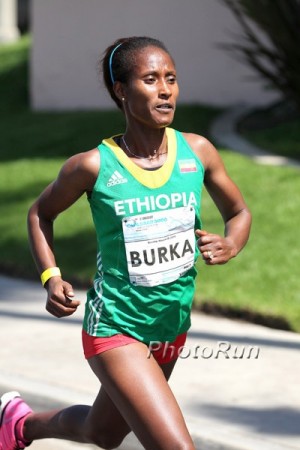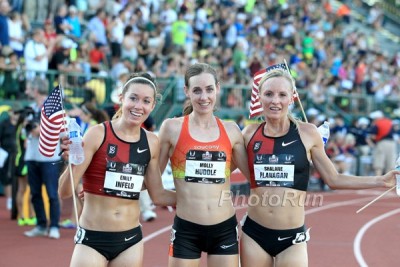2015 World Women’s 10,000 Preview: Can anyone stop Vivian Cheruiyot from returning to the winner’s circle and winning a 4th track gold? Will Molly Huddle medal?
by LetsRun.com
August 20, 2015
African-born women have dominated the women’s 10,000 for the past six years — no one born outside of Kenya/Ethiopia has finished in the top four at a Worlds/Olympics since Shalane Flanagan took bronze in 2008. That being said, there are two big reasons to be optimistic if you’re a fan of American distance running.
1. Reigning World/Olympic champ Tirunesh Dibaba, who has won five global golds at this distance altogether, took 2015 off to have a baby and won’t be competing in Beijing. 2013 silver medalist Gladys Cherono didn’t run the Kenyan trials and won’t be back either; in fact, six of the top seven from Moscow will be absent, with only bronze medalist Belaynesh Oljira returning in 2015.
That’s not to say the field is a joke. It’s a World Championships, after all. Kenya will send the experienced Vivian Cheruiyot (2009 gold medallist at 5000, 2011 gold at 5000 and 10,000, 2012 Olympic bronze medalist at 10,000) in addition to former NCAA stars Sally Kipyego (2011 world/2012 Olympic silver medalist) and Betsy Saina (14:39/30:57 PBs), while the Ethiopian squad will also be formidable with Oljira, Alemitu Haroye (world junior 5,000 champ/4th at World XC) and 2015 world leader Gelete Burka, winner of the Ethiopian trials on June 17 in Hengelo. Those are two very solid teams, but without Dibaba in the field, there’s less certainty in years past and that makes for a more exciting race.
2) American Molly Huddle is in great shape and is legitimate medal contender, especially considering the two-year run American champ Molly Huddle has put together.
|
Race Time: 8:35 am ET Monday Morning (Monday evenign China) 2013 Worlds Results 2015s Fastest performers (among women entered) |
The Heavy Favorite
We’ll get to Huddle in a bit, but any discussion of this race has to start with Vivian Cheruiyot. Cheruiyot, 31, is the most talented woman in the field by far and should be considered the heavy favorite. After missing all of 2013 and 2014 after giving birth to her son in October 2013, Cheruiyot returned to action by taking third at the Kenyan Police Cross Country Championships in January and has steadily regained the form that saw her pull off the 5,000/10,000 double at the 2011 Worlds and take silver and bronze in the same events at the 2012 Olympics.
The Cheruiyot of 2011 was one of the greatest distance runners the world has ever seen (she also managed to run 14:20 for 5,000 that season) and it’s difficult to expect Cheruiyot, who competed in the 2000 Olympics at age 17, to be that good after taking so much time off. However, the recent signs have been promising enough to install her as the favorite for gold.
In her first track race since her break, Cheruiyot ran 14:46 for 5,000 at the Pre Classic on May 30, finishing ahead of Kipyego and Haroye and behind only Genzebe Dibaba and Faith Kipyegon, neither of whom will run the 10,000 at Worlds. After that, she ran 8:39 for 3,000 in Rabat on June 14 (behind only 14:14 woman Almaz Ayana, who won’t be in the 10,000) before winning her next three races, sandwiching 10,000 victories in Brussels (31:13) and at the Kenyan Trials (32:58 at altitude) with a victory in the 1500 at the Kenyan championships on July 11 (4:09.88 at altitude). Given her championship pedigree and recent form, Cheruiyot is the woman to beat in Beijing.
After Cheruiyot, the other medals are very much up for grabs.
The two American-based Kenyans and former NCAA stars, Sally Kipyego and Betsy Saina, both are contenders. Out of the rest of the field, Kipyego has has the most championships success, and though she ran 14:47 at Pre — just a second beind Cheruiyot and a second ahead of Haroye — she was also a DNF at the Kenyan Trials. In fact, Kipyego hasn’t finished a 10,000 since May 4, 2014, three days after the qualifying window opened (she ran 30:42 at Stanford). Saina, hasn’t been running as well over 5,000 as she did last year (her 2015 SB is 15:00 compared to 14:39 last year) but she’s been a force over 10,000. Saina won the Great Manchester 10K on May 10, finished second to Mary Keitany at the NY Mini 10K in June and beat out Commonwealth/African champ Joyce Chepkirui, Gladys Chesire and World XC champ Agnes Jebet Tirop for the second spot at the Kenyan Trials.
Clearly Saina, who is based in Colorado Springs under coach Scott Simmons, has more experience at the 10,000 distance this year, but will that be enough to giver her the edge over Kipyego and her championship medals? Kipyego has beaten Saina three times this year at distances below 10,000 (Saina DNF’ed once, which we’re counting as a defeat) while Saina came out on top at the Kenyan Trials (where Kipyego DNF’ed). Who comes out on top between them likely comes down to how fast the race goes — Kipyego has an edge in a slower race; Saina’s chances are better in a faster race.
Of course, the Kenyans are not the only medal threats in this race. Ethiopia perennially sends a strong team, and even without Dibaba, it could grab a medal or two in Beijing. Belaynesh Oljira, the returning bronze medalist, seems the least likely to medal as she only ran 15:05 for 5,000 in Paris on July 4 (placing 9th in the DL meet, though Saina was even further back) and was third at the Ethiopian Trials. Trials champ Gelete Burka and world junior 5,000 champ Alemitu Haroye are serious medal threats, however, as both have run multiple fast 5,000s this year. Burka has run 14:40 (Paris) and 14:41 (Oslo), while Haroye has run 14:43 (Shanghai), 14:44 (Paris) and 14:48 (Eugene).
Burka’s margin of victory at the trials over Haroye was narrow (1.15 seconds) but she is 2-1 against the 20-year-old this year (wins in Paris and the Trials; a loss in Shanghai) and has far more experience on the global stage: she’s competed at every World Champs/Olympics since 2005, albeit never in the 10,000. One thing going against the 29-year old Burka is that she’d never even run a 10,000 until this year. It should be remembed that she’s a former 1500 runner (3:58.79 pb) who twice won medals indoors at that distance (gold in 2008, bronze in 2010). At the 2013 Worlds, Burks was in the 1500 where she went out in the heats. But to conclude because of her 1500 background that 10,000 is necessarily too far for her would be a mistake. Burka has run a 2:26:03 marathon (Houston 2015).
Haroye, meanwhile, will be making her senior World Champs debut, though she has run at both world juniors and World XC (senior race) in the past two years. Given Burka won the trials and has run faster than anyone else in the field over both 5,000 and 10,000 this year, she is the best bet for an Ethiopian medal — and could challenge Cheruiyot for gold.
An American Medal?
It’s close to a lock that at least two of the three medals will go to African runners. But in the recent past, American women on the top of their game have won medals at this distance (an American man has never won a medal in the 10,000 at Worlds), with Kara Goucher pulling the trick at Worlds in 2007 and Shalane Flanagan doing the same at the following year’s Olympics. Huddle, like Goucher and Flanagan, is a true talent at the peak of her powers and it’s obvious that by stepping up to the 10,000 this year, she wants to join Goucher, Flanagan and Lynn Jennings as the only American women to win a World/Olympic medal in the 5,000/10,000.
Huddle certainly made the right choice in pursuing the 10,000. Though her 14:42.64 5,000 in Monaco last year was faster than any American woman had run in history, it was only good enough for sixth place in that race. This year, with Almaz Ayana and Genzebe Dibaba both having run 14:15 or better — and five other women running 14:40 or faster — Huddle would have needed to improve tremendously to even sniff a medal in the 5,000.
The 10,000 is a different matter. As Goucher and Flanagan have shown, Americans can win medals in the 10,000 and Huddle’s 30:47.59 PR is the #2 time in the world over the past two years. She can absolutely medal at Worlds.
The problem is, it can be difficult to evaluate who’s in the best 10,000 shape heading into Worlds. Unlike the shorter events, top international 10,000s aren’t run frequently and the best runners are rarely all in the same race outside of Worlds/the Olympics. That’s how you get big surprises, such as little-known Ibrahim Jeilan taking the world title ahead of Mo Farah in 2011.
So far, the signs are looking promising for Huddle. In March, she won the NYC Half Marathon in 68:31, ahead of Joyce Chepkirui (3rd at the Kenyan 10,000 trials but not selected; African/Commonwealth 10,000 champ in ’14), Kipyego and Caroline Rotich, who would go on to win the Boston Marathon a month later. Kipyego is the only one of those three who will be in Beijing, but Huddle can take confidence from the fact that she didn’t just beat the Olympic silver medalist — she destroyed her, finishing 1:08 ahead of Kipyego.
In her next race, on April 18, Huddle beat another Beijing medal contender and the Ethiopian Trials champ Gelete Burka by seven seconds to win the B.A.A. 5K in 14:50 (Burka was fourth). Huddle has raced three more times since then, and all three races have gone very well. She ran a 14:57 at the New Balance Twilight meet on June 13, convincingly won the U.S. 10,000 title thanks to a 65-second last lap and almost earned the win in the 5,000 at the Sainsbury’s Anniversary Games on July 25 before Kenyan stud Mercy Cherono ran her down in the final laps. When the reigning Diamond League champ/world silver medalist has to work hard to beat you at 5,000, you’re in good shape.
The 10,000 appears to be Huddle’s sweet spot right now. Huddle had experimented with longer stuff in the past, but 2014 was the year she really committed to more strength work and began racing distances longer than 5,000, and she was rewarded with PRs of 30:47 and 69:03 in the 10,000 and half marathon. She’s only improved since then, and her 14:50 on the roads in Boston in April and American record over 5,000 last year showed that she still has plenty of speed.
Kipyego and Burka are the only medal contenders Huddle has gone up against this year, and though neither race was at 10,000, the fact that she won both races is a very encouraging sign. And she’s at least as good as Goucher and Flanagan were heading into their medal-winning performances, as shown below:
Kara Goucher, 2007
PBs: 4:05/15:08/31:17
USA result: 2nd in 10,000 in 32:33 (lost to Deena Kastor by 36 seconds)
Worlds result: 3rd in 32:02.05
Shalane Flanagan, 2008
PBs: 4:05/14:44/30:34
USA result: 1st in 10,000 in 31:34 (won by three seconds over Goucher); 3rd in 5,000 in 15:02 (lost to Goucher by 1.79 seconds and Jen Rhines by .79)
Olympics result: 3rd in 30:22.22
Molly Huddle, 2015
PBs: 4:08/14:42/30:47
USA result: 1st in 10,000 in 31:39 (won by three seconds over Flanagan)
Worlds result: ???
Huddle’s strength is superior to Goucher’s and likely close to Flanagan’s (it’s been a year since Huddle’s 30:47; we bet she could run in the 30:30s or faster in Stanford-like conditions right now). The one sticking point is her 1500 speed, which is three seconds slower than both Goucher and Flanagan (both of them ran their 1500 PBs the year before their medals; Huddle’s PB is from two years ago). But how important is 1500 speed really? Goucher, a 4:05 woman at the time, outkicked Jo Pavey for her medal; Pavey had a 4:01 1500 PB and her 5,000 best of 14:39 (from the year before) was almost 30 seconds better than Goucher’s. Even though the race was slow, with Goucher medaling despite a time outside 32:00, her strength (she would win the Great North Run in 66:57 the next month) was still an important factor.
Of course, Huddle will be facing a different field than Goucher or Flanagan, but everything she’s done over the past two years points to a medal being a realistic outcome in Beijing.
The Other Americans
Flanagan’s appearance marks her ninth straight appearance at Worlds/Olympics, a streak that dates back to her first Olympic appearance in the 5,000 in Athens in 2004. Only Allyson Felix (who has made 10 straight teams) has a longer streak, though we’ll give an honorable mention to Amy Acuff, who has made 13 teams (beginning in 1995; she didn’t jump at all in ’11 or ’13 but has otherwise made every team) and finished third at USAs this year (though she doesn’t have the IAAF standard).
The 34-year-old Flanagan, who has focused her attention on the marathon in recent years, is no longer a medal threat on the track, but she still has a decent shot to repeat her finish of eighth from two years ago. Flanagan is the second returner from Moscow, where she was the second non-African-born finisher, and though Huddle is clearly the superior 10,000 runner now, Flanagan’s goose is hardly cooked over the 25-lap distance. Back on April 3, when Flanagan was just three weeks out from the Boston Marathon, she led Burka for almost all of the 10,000 at the Stanford Invitational before Burka took off on the last lap and beat her by less than a second, 31:08.16 to 31:09.02.
Things have obviously changed since then. Burka was just beginning her season (her season opener had come five days earlier at the Carlsbad 5000) and more importantly running the first 10,000 of her career so she was probably playing it safe while Flanagan was nearing peak fitness (albeit for a much longer race). Flanagan has since taken time off and before building back up while Burka’s progression has been uninterrupted, most recently resulting in a PR at 10,000 and her fastest 5,000 time in eight years. It’s unlikely Flanagan will have been able to make up that ground on Burka before Worlds, but finishing so close to her in a 10,000 four months ago is a good sign. Finishing in the top five would be a great day for Flanagan; a good one would see her in the six to nine range.
Flanagan’s 25-year-old training partner Emily Infeld rounds out Team USA in the 10,000. She’s not nearly as experienced as Flanagan (this is her first appearance at Worlds) but she almost beat Flanagan in the 10,000 at USAs (she was .31 of a second behind) and did beat Flanagan in the 5,000 (finishing 2.84 seconds ahead). She should have the same goals as Flanagan for this race.
The worry for Infeld is that 10 women in this field have run faster than her for 10,000 this year, and that doesn’t include Huddle, Saina or Kipyego. Infeld, of course, hadn’t run any 10,000s at all before her 31:38 debut at Payton Jordan, and going into that race she had only six weeks of training under her belt — initially coach Jerry Schumacher just wanted her to tempo it — and considering she ran just four seconds slower at USAs in hotter championship conditions, she should be in 31:10-20 shape if her training has gone well since USAs. Beating Flanagan and breaking into the top 8 would be a great day for Infeld and would position her nicely heading into next year’s Olympic Game and be a sign she could possibly could be the next American long distance star in the Kastor/Goucher/Flanagan/Huddle line.
LRC Prediction: 1. Cheruiyot 2. Burka 3. Huddle
When she’s on her game, no one in this field can touch Cheruiyot and she’s shown enough this year for us to pick her despite a great year from Burka who w. Huddle has been on fire the last two years and she’ll validate the decision to move up to the 10,000 with a medal here.
Top 11 Seasonal Best Times of Entrants
| 1 | 30:49.68 | Gelete Burka | ETH |
| 2 | 30:50.83 | Alemitu Haroye | ETH |
| 3 | 30:53.69 | Belaynesh Oljira | ETH |
| 4 | 31:09.02 | Shalane Flanagan | USA |
| 5 | 31:12.93 | Sara Moreira | POR |
| 6 | 31:13.29 | Vivian Cheruiyot | KEN |
| 7 | 31:31.97 | Susan Kuijken | NED |
| 8 | 31:34.17 | Dulce Félix | POR |
| 9 | 31:35.48 | Jip Vastenburg | NED |
| 10 | 31:37.32 | Yuka Takashima | JPN |
| 11 | 31:38.71 | Emily Infeld | USA |



